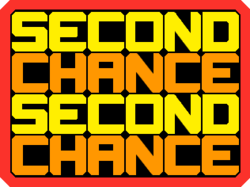Today, these contestants will be risking everything they've won every
time they play...

SHOW: SECOND CHANCE
AIR DATES: March 7, 1977 to July 15, 1977
CREATOR: Bill Carruthers & Jan McCormack
HOST: Jim Peck
WATCH IT AT: youtu.be/39WU-9UO4LA
Everyone who was alive in the mid-1980s remembers "Press Your Luck",
right? Hell, even those who watched USA Network in the 80s and 90s or
saw the GSN special about Michael Larson have at least heard of it. And
GSN tried to bring it back in the early 2000s. It was the game of "big
bucks and no Whammies". Where fortunes are won and lost with every
"spin". But NOT too many people realize that, before CBS made a buttload
on this lead-in to "The Price Is Right", Bill Carruthers (creator of PYL)
gave a VERY similar idea to ABC. This version, called "Second Chance",
had non-animated "Devils" instead of screeching red Whammies, a very
static board with a wickedly fast-moving light window and a front-end
game that...well, let's just say we're glad they revamped it for PYL.
HOW WAS IT PLAYED?
Three
contests played the game (there we no returning champions). The game is
divided into two rounds, each with two different parts; one to earn
"spins" and one to USE them.
In the first part of each round, the host asks a question. Each
contestant has ten seconds to write an answer down on some cardboard and
show it to the host (though no contest knew what the others wrote down).
After the answers are shown, the host then gives a multiple choice where
one is the correct answer and - having said that at least one of the
contestants have the right or wrong answer - gives them a "second
chance" to write down the right answer out of the three given. If a
contestant gets it tight the first time, they get three spins; if they
get it right on the "second chance" they get one spin.
After three questions, the contestants use the spins earned on the "Big
Board": eighteen squares arranged in a rectangle with various amounts of
money, several "prize" spaces (covered and not revealed unless hit) and
three "Devil"s. The contestant with the least number of spins goes
first. A "spin" consisted of a lighted frame which zipped around the
squares and ended with a contestant smacked a buzzer (yelling "STOP" was
optional). Whatever the frame landed on was added to the contestants
score. Landing on a "Devil" would reset the contestant's score to zero.
Hitting four "Devils" over the course of the game would eliminate the
contestant from the game. Because of this, the contestant could, after
at least one spin, pass their remaining spins to the contest with the
most money. Passed spins MUST be played and could not be re-passed. If a
"Devil" is hit on a passed spin, the remaining passed spins became
"earned" spins which COULD be re-passed.
The top amount on the board started at $2500 in Round 1 and $5000 in
Round 2. Later, an "extra spin" was added to both. Later still, the
Round 1 top amount dropped to $1000 and the Round 2 top amount was
randomly changed between $1000 and $5000 (in increments of $1000) and
the extra spin. Prize were generally three-digit prices in Round 1 and
four-digit in Round 2.
Only the contestant who earned the most in cash and prizes without
hitting four "Devil"s won the game and took home the winnings.
WHAT WORKED?
C'mon, if you've seen PYL, you know what worked for it. It's the same
that worked for its predecessor. It could definitely have been called
"the most exciting games of their lives" back in the 70s as you never
knew where the frame would show up on the board once the button was hit.
Would it be cash? A mystery prize? Or would the "Devil" do what its twin
did on "The Joker's Wild"? Believe it or not, there WAS a pattern to how
the frame flashed on the board...though I doubt even Larson could've
figured it out.
It's a little thing...but I did like how the "Big Board" opened up like
a sideways clamshell when it was time to use the spins. Made the big
board look, well, BIGGER than it was. Almost wished the PYL board did
that...but that probably would've been impractical.
WHAT DIDN'T WORK?
The first half of each round...was boring. There's no other way to put
it. Oh, it STARTS fine...but the "second chance" that the show is named
for...it slowed down the game even more. It was just too much of a
downshift from the second half to sustain interest.
Any other gripes I have with SC come from how different it is from PYL,
the show that would succeed it (and succeed rather well). The board was
static, the frame jumping could give someone a seizure if they tried to
follow it, not having the prizes visible was a little off-putting
and...at least the Whammies DID things when they took the money. The "Devil"s
just...synth-farted while they sat there on the board. Maybe PYL spoiled
me...but I'm glad Carruthers made the changes he did before re-pitching
the idea to CBS.
WOULD IT WORK TODAY?
Not in THIS format. As I said, the PYL "upgrade" was far superior to the
original: more action-packed, more random, more exciting...and more
funny with the Whammy animations. And a re-boot of PYL proved
quasi-successful on GSN, something I doubt SC could achieve. "Second
Chance" was, essentially, the "pilot" series for a far better show.
Let's thank the guys for the sneak preview and leave it to the archives.
NEXT TIME: If
computers played "Pictionary"...
Chris Wolvie knows the Devil is in the details. Follow him on Twitter @ChrisWolvie and
e-mail him at chriswolvie@yahoo.com |


